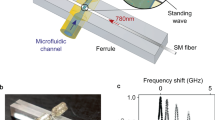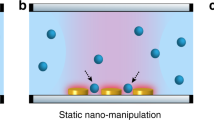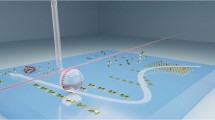Abstract
Raman/fluorescence microspectroscopic analysis of individual polymer chains and nanobeads dissolved in solution will become a powerful analytical method to study their molecular structure and characteristics. With this motivation, we focused on the use of Raman microspectroscopy for optically trapped soft matter. A tightly focused near-infrared laser beam formed a microassembly of thermoresponsive polymer chains such as poly(N-isopropylacrylamide) due to a local photothermal effect and optical force. By using this method, we developed a technique for determining the polymer concentration in a polymer microassembly. Furthermore, we demonstrated a molecular condensation and detection technique based on microassembly on plasmonic nanostructures. For this molecular condensation and detection process, localized surface plasmons play an essential role in the optical force enhancement and local temperature increase around the plasmonic nanostructures. Finally, aiming toward novel manipulation methods of smaller soft nanomaterials, nanostructured semiconductor-assisted (NASSCA) optical tweezers are introduced. In this paper, we reviewed the optical manipulation methods of polymer chains and nanobeads and their applications in analytical chemistry.
This is a preview of subscription content, access via your institution
Access options
Subscribe to this journal
Receive 12 print issues and online access
$259.00 per year
only $21.58 per issue
Buy this article
- Purchase on Springer Link
- Instant access to full article PDF
Prices may be subject to local taxes which are calculated during checkout







Similar content being viewed by others
References
Heskins M, Guillet JE. Solution properties of poly(N-isopropylacrylamide). J Macromol Sci Part A Chem. 1968;2:1441–55.
Fujishige S, Kubota K, Ando I. Phase transition of aqueous solutions of poly (N-isopropylacrylamide) and poly (N-isopropylmethacrylamide). J Phys Chem. 1989;93:3311–3.
Wu C, Zhou S. Thermodynamically stable globule state of a single poly(N-isopropylacrylamide) chain in water. Macromolecules. 1995;28:5388–90.
Wang X, Qiu X, Wu C. Comparison of the coil-to-globule and the globule-to-coil transitions of a single poly(N -isopropylacrylamide) homopolymer chain in water. Macromolecules. 1998;31:2972–6.
Wu C, Wang X. Globule-to-coil transition of a single homopolymer chain in solution. Phys Rev Lett. 1998;80:4092–4.
Cheng H, Shen L, Wu C. LLS and FTIR studies on the hysteresis in association and dissociation of poly(N-isopropylacrylamide) chains in water. Macromolecules. 2006;39:2325–9.
Kujawa P, Segui F, Shaban S, Diab C, Okada Y, Tanaka F, et al. Impact of end-group association and main-chain hydration on the thermosensitive properties of hydrophobically modified telechelic poly(N-isopropylacrylamides) in water. Macromolecules. 2006;39:341–8.
Kuang C, Yusa S, Sato T. Micellization and phase separation in aqueous solutions of thermosensitive block copolymer poly(N-isopropylacrylamide)-b-poly(N-vinyl-2-pyrrolidone) upon heating. Macromolecules. 2019;52:4812–9.
Meier-Koll A, Pipich V, Busch P, Papadakis CM, Müller-Buschbaum P. Phase separation in semidilute aqueous poly(N-isopropylacrylamide) solutions. Langmuir. 2012;28:8791–8.
Stieger M, Pedersen JS, Lindner P, Richtering W. Are thermoresponsive microgels model systems for concentrated colloidal suspensions? A rheology and small-angle neutron scattering study. Langmuir. 2004;20:7283–92.
Maeda Y, Higuchi T, Ikeda I. Change in hydration state during the coil−globule transition of aqueous solutions of poly(N -isopropylacrylamide) as evidenced by FTIR spectroscopy. Langmuir. 2000;16:7503–9.
Plamper FA, Steinschulte AA, Hofmann CH, Drude N, Mergel O, Herbert C, et al. Toward copolymers with ideal thermosensitivity: solution properties of linear, well-defined polymers of N-isopropyl acrylamide and N,N-diethyl acrylamide. Macromolecules. 2012;45:8021–6.
Ahmed Z, Gooding EA, Pimenov KV, Wang L, Asher SA. UV resonance Raman determination of molecular mechanism of poly(N-isopropylacrylamide) volume phase transition. J Phys Chem B. 2009;113:4248–56.
Ono Y, Shikata T. Hydration and dynamic behavior of poly(N-isopropylacrylamide)s in aqueous solution: a sharp phase transition at the lower critical solution temperature. J Am Chem Soc. 2006;128:10030–1.
Füllbrandt M, Ermilova E, Asadujjaman A, Hölzel R, Bier FF, von Klitzing R, et al. Dynamics of linear poly(N -isopropylacrylamide) in water around the phase transition investigated by dielectric relaxation spectroscopy. J Phys Chem B. 2014;118:3750–9.
Starovoytova L, Spěváček J. Effect of time on the hydration and temperature-induced phase separation in aqueous polymer solutions. 1H NMR study. Polymer. 2006;47:7329–34.
Spěváček J, Konefał R, Čadová E. NMR study of thermoresponsive block copolymer in aqueous solution. Macromol Chem Phys. 2016;217:1370–5.
Tiktopulo EI, Bychkova VE, Ricka J, Ptitsyn OB. Cooperativity of the coil-globule transition in a homopolymer: microcalorimetric study of poly(N-isopropylacrylamide). Macromolecules. 1994;27:2879–82.
Zhou X, Li J, Wu C, Zheng B. Constructing the phase diagram of an aqueous solution of poly(n-isopropyl acrylamide) by controlled microevaporation in a nanoliter microchamber. Macromol Rapid Commun. 2008;29:1363–7.
Tsuboi Y, Yoshida Y, Okada K, Kitamura N. Phase separation dynamics of aqueous solutions of thermoresponsive polymers studied by a laser T-jump technique. J Phys Chem B. 2008;112:2562–5.
Tsuboi Y, Tada T, Shoji T, Kitamura N. Phase-separation dynamics of aqueous poly (N-isopropylacrylamide) solutions: characteristic behavior of the molecular weight and concentration dependences. Macromol Chem Phys. 2012;213:1879–84.
Tada T, Katsumoto Y, Goossens K, Uji-i H, Hofkens J, Shoji T, et al. Accelerating the phase separation in aqueous poly(N-isopropylacrylamide) solutions by slight modification of the polymer stereoregularity: a Single Molecule Fluorescence Study. J Phys Chem C. 2013;117:10818–24.
Tada T, Hirano T, Ute K, Katsumoto Y, Asoh T-A, Shoji T, et al. Effects of syndiotacticity on the dynamic and static phase separation properties of poly(N-isopropylacrylamide) in aqueous solution. J Phys Chem B. 2016;120:7724–30.
Matsumoto M, Wakabayashi R, Tada T, Asoh T-A, Shoji T, Kitamura N, et al. Rapid phase separation in aqueous solution of temperature-sensitive poly(N, N -diethylacrylamide). Macromol Chem Phys. 2016;217:2576–83.
Matsumoto M, Tada T, Asoh T-A, Shoji T, Nishiyama T, Horibe H, et al. Dynamics of the phase separation in a thermoresponsive polymer: accelerated phase separation of stereocontrolled poly(N, N-diethylacrylamide) in water. Langmuir. 2018;34:13690–6.
Schmaljohann D. Thermo- and pH-responsive polymers in drug delivery. Adv Drug Deliv Rev. 2006;58:1655–70.
Nagase K, Yamato M, Kanazawa H, Okano T. Poly(N-isopropylacrylamide)-based thermoresponsive surfaces provide new types of biomedical applications. Biomaterials. 2018;153:27–48.
Van Vlierberghe S, Dubruel P, Schacht E. Biopolymer-based hydrogels as scaffolds for tissue engineering applications: a review. Biomacromolecules. 2011;12:1387–408.
Doberenz F, Zeng K, Willems C, Zhang K, Groth T. Thermoresponsive polymers and their biomedical application in tissue engineering—a review. J Mater Chem B. 2020;8:607–28.
Xu X, Liu Y, Fu W, Yao M, Ding Z, Xuan J, et al. Poly(N-isopropylacrylamide)-based thermoresponsive composite hydrogels for biomedical applications. Polymers. 2020;12:580.
Maeda Y, Yamamoto H, Ikeda I. Phase separation of aqueous solutions of poly(N-isopropylacrylamide) investigated by confocal Raman microscopy. Macromolecules. 2003;36:5055–7.
Ashkin A, Dziedzic JM. Optical levitation by radiation pressure. Appl Phys Lett. 1971;19:283–5.
Ashkin A, Dziedzic JM, Bjorkholm JE, Chu S. Observation of a single-beam gradient force optical trap for dielectric particles. Opt Lett. 1986;11:288.
Ashkin A, Dziedzic JM, Yamane T. Optical trapping and manipulation of single cells using infrared laser beams. Nature. 1987;330:769–71.
Ashkin A. Optical trapping and manipulation of neutral particles using lasers. Proc Natl Acad Sci. 1997;94:4853–60.
Ashkin A, Dziedzic J. Optical trapping and manipulation of viruses and bacteria. Science. 1987;235:1517–20.
Tsuboi Y, Nishino M, Sasaki T, Kitamura N. Poly(N-Isopropylacrylamide) microparticles produced by radiation pressure of a focused laser beam: a structural analysis by confocal raman microspectroscopy combined with a laser-trapping technique. J Phys Chem B. 2005;109:7033–9.
Tsuboi Y, Nishino M, Matsuo Y, Ijiro K, Kitamura N. Phase separation of aqueous poly(vinyl methyl ether) solutions induced by the photon pressure of a focused near-infrared laser beam. Bull Chem Soc Jpn. 2007;80:1926–31.
Shoji T, Nohara R, Kitamura N, Tsuboi Y. A method for an approximate determination of a polymer-rich-domain concentration in phase-separated poly(N-isopropylacrylamide) aqueous solution by means of confocal Raman microspectroscopy combined with optical tweezers. Anal Chim Acta. 2015;854:118–21.
Shoji T, Sugo D, Nagasawa F, Murakoshi K, Kitamura N, Tsuboi Y. Highly sensitive detection of organic molecules on the basis of a poly(N-isopropylacrylamide) microassembly formed by plasmonic optical trapping. Anal Chem. 2017;89:532–7.
Shoji T, Mototsuji A, Balčytis A, Linklater D, Juodkazis S, Tsuboi Y. Optical tweezing and binding at high irradiation powers on black-Si. Sci Rep. 2017;7:12298.
Hanasaki I, Shoji T, Tsuboi Y. Regular assembly of polymer nanoparticles by optical trapping enhanced with a random array of Si needles for reconfigurable photonic crystals in liquid. ACS Appl Nano Mater. 2019;2:7637–43.
Svoboda K, Block SM. Optical trapping of metallic Rayleigh particles. Opt Lett. 1994;19:930.
Kendrick MJ, McIntyre DH, Ostroverkhova O. Wavelength dependence of optical tweezer trapping forces on dye-doped polystyrene microspheres. J Opt Soc Am B. 2009;26:2189–98.
Hosokawa C, Yoshikawa H, Masuhara H. Optical assembling dynamics of individual polymer nanospheres investigated by single-particle fluorescence detection. Phys Rev E. 2004;70:061410.
Tsuboi Y, Shoji T, Kitamura N. Crystallization of lysozyme based on molecular assembling by photon pressure. Jpn J Appl Phys. 2007;46:L1234–L1236.
Tsuboi Y, Shoji T, Nishino M, Masuda S, Ishimori K, Kitamura N. Optical manipulation of proteins in aqueous solution. Appl Surf Sci. 2009;255:9906–8.
Shoji T, Kitamura N, Tsuboi Y. Resonant excitation effect on optical trapping of myoglobin: the important role of a heme cofactor. J Phys Chem C. 2013;117:10691–7.
Tsuboi Y, Shoji T, Kitamura N. Optical trapping of amino acids in aqueous solutions. J Phys Chem C. 2010;114:5589–93.
Yan H, Hou Y-F, Niu P-F, Zhang K, Shoji T, Tsuboi Y, et al. Biodegradable PLGA nanoparticles loaded with hydrophobic drugs: confocal Raman microspectroscopic characterization. J Mater Chem B. 2015;3:3677–80.
Yang J, Zhang R-N, Liu D-J, Zhou X, Shoji T, Tsuboi Y, et al. Laser trapping/confocal Raman spectroscopic characterization of PLGA-PEG nanoparticles. Soft Matter. 2018;14:8090–4.
Borowicz P, Hotta J, Sasaki K, Masuhara H. Laser-controlled association of poly(N-vinylcarbazole) in organic solvents: radiation pressure effect of a focused near-infrared laser beam. J Phys Chem B. 1997;101:5900–4.
Borowicz P, Hotta J, Sasaki K, Masuhara H. Chemical and optical mechanism of microparticle formation of Poly(N-vinylcarbazole) in N, N-dimethylformamide by photon pressure of a focused near-infrared laser beam. J Phys Chem B. 1998;102:1896–901.
Singer W, Nieminen TA, Heckenberg NR, Rubinsztein-Dunlop H. Collecting single molecules with conventional optical tweezers. Phys Rev E. 2007;75:011916.
Ishikawa M, Misawa H, Kitamura N, Masuhara H. Poly(N-isopropylacrylamide) microparticle formation in water by infrared laser-induced photo-thermal phase transition. Chem Lett. 1993;22:481–4.
Ishikawa M, Misawa H, Kitamura N, Fujisawa R, Masuhara H. Infrared laser-induced photo-thermal phase transition of an aqueous poly(N-isopropylacrylamide) solution in the micrometer dimension. Bull Chem Soc Jpn. 1996;69:59–66.
Masuo S, Yoshikawa H, Nothofer H-G, Grimsdale AC, Scherf U, Müllen K, et al. Assembling and orientation of polyfluorenes in solution controlled by a focused near-infrared laser beam. J Phys Chem B. 2005;109:6917–21.
Nabetani Y, Yoshikawa H, Grimsdale AC, Müllen K, Masuhara H. Effects of optical trapping and liquid surface deformation on the laser microdeposition of a polymer assembly in solution. Langmuir. 2007;23:6725–9.
Ito S, Sugiyama T, Toitani N, Katayama G, Miyasaka H. Application of fluorescence correlation spectroscopy to the measurement of local temperature in solutions under optical trapping condition. J Phys Chem B. 2007;111:2365–71.
Volpe G, Quidant R, Badenes G, Petrov D. Surface plasmon radiation forces. Phys Rev Lett. 2006;96:238101.
Galloway CM, Kreuzer MP, Aćimović SS, Volpe G, Correia M, Petersen SB, et al. Plasmon-assisted delivery of single nano-objects in an optical hot spot. Nano Lett. 2013;13:4299–304.
Shoji T, Tsuboi Y. Plasmonic optical tweezers toward molecular manipulation: tailoring plasmonic nanostructure, light source, and resonant trapping. J Phys Chem Lett. 2014;5:2957–67.
Shoji T, Tsuboi Y. Plasmonic optical trapping of soft nanomaterials such as polymer chains and DNA: micro-patterning formation. Opt Rev. 2015;22:137–42.
Dienerowitz M, Mazilu M, Dholakia K. Optical manipulation of nanoparticles: a review. J Nanophotonics. 2008;2:021875.
Wu J, Gan X. Three dimensional nanoparticle trapping enhanced by surface plasmon resonance. Opt Exp. 2010;18:27619–26.
Tsuboi Y, Shoji T, Kitamura N, Takase M, Murakoshi K, Mizumoto Y, et al. Optical trapping of quantum dots based on gap-mode-excitation of localized surface plasmon. J Phys Chem Lett. 2010;1:2327–33.
Shoji T, Shibata M, Kitamura N, Nagasawa F, Takase M, Murakoshi K, et al. Reversible photoinduced formation and manipulation of a two-dimensional closely packed assembly of polystyrene nanospheres on a metallic nanostructure. J Phys Chem C. 2013;117:2500–6.
Shoji T, Mizumoto Y, Ishihara H, Kitamura N, Takase M, Murakoshi K, et al. Plasmon-based optical trapping of polymer nano-spheres as explored by confocal fluorescence microspectroscopy: a possible mechanism of a resonant excitation effect. Jpn J Appl Phys. 2012;51:092001.
Mototsuji A, Shoji T, Wakisaka Y, Murakoshi K, Yao H, Tsuboi Y. Plasmonic optical trapping of nanometer-sized J- /H- dye aggregates as explored by fluorescence microspectroscopy. Opt Exp. 2017;25:13617.
Shoji T, Saitoh J, Kitamura N, Nagasawa F, Murakoshi K, Yamauchi H, et al. Permanent fixing or reversible trapping and release of DNA micropatterns on a gold nanostructure using continuous-wave or femtosecond-pulsed near-infrared laser light. J Am Chem Soc. 2013;135:6643–8.
Shoji T, Itoh K, Saitoh J, Kitamura N, Yoshii T, Murakoshi K, et al. Plasmonic Manipulation of DNA using a combination of optical and thermophoretic forces: separation of different-sized DNA from mixture solution. Sci Rep. 2020;10:3349.
Toshimitsu M, Matsumura Y, Shoji T, Kitamura N, Takase M, Murakoshi K, et al. Metallic-nanostructure-enhanced optical trapping of flexible polymer chains in aqueous solution as revealed by confocal fluorescence microspectroscopy. J Phys Chem C. 2012;116:14610–8.
McNay G, Eustace D, Smith WE, Faulds K, Graham D. Surface-enhanced raman scattering (SERS) and surface-enhanced resonance raman scattering (SERRS): a review of applications. Appl Spectrosc. 2011;65:825–37.
Vo-Dinh T, Wang H-N, Scaffidi J. Plasmonic nanoprobes for SERS biosensing and bioimaging. J Biophotonics. 2010;3:89–102.
Alvarez-Puebla RA, Liz-Marzán LM. Traps and cages for universal SERS detection. Chem Soc Rev. 2012;41:43–51.
Yuan Y, Lin Y, Gu B, Panwar N, Tjin SC, Song J, et al. Optical trapping-assisted SERS platform for chemical and biosensing applications: design perspectives. Coord Chem Rev. 2017;339:138–52.
Schlücker S. Surface-enhanced raman spectroscopy: concepts and chemical applications. Angew Chem Int Ed. 2014;53:4756–95.
Fan X, White IM, Shopova SI, Zhu H, Suter JD, Sun Y. Sensitive optical biosensors for unlabeled targets: a review. Anal Chim Acta. 2008;620:8–26.
Peng HI, Miller BL. Recent advancements in optical DNA biosensors: exploiting the plasmonic effects of metal nanoparticles. Analyst. 2011;136:436–47.
Ueno K, Misawa H. Surface plasmon-enhanced photochemical reactions. J Photochem Photobiol C. 2013;15:31–52.
Ueno K, Juodkazis S, Shibuya T, Yokota Y, Mizeikis V, Sasaki K, et al. Nanoparticle plasmon-assisted two-photon polymerization induced by incoherent excitation source. J Am Chem Soc. 2008;130:6928–9.
Brus L. Noble metal nanocrystals: plasmon electron transfer photochemistry and single-molecule Raman spectroscopy. Acc Chem Res. 2008;41:1742–9.
Ueno K, Misawa H. Photochemical reaction fields with strong coupling between a photon and a molecule. J Photochem Photobiol A. 2011;221:130–7.
Baffou G, Quidant R. Nanoplasmonics for chemistry. Chem Soc Rev. 2014;43:3898–907.
Nagasawa F, Takase M, Murakoshi K. Raman enhancement via polariton states produced by strong coupling between a localized surface plasmon and dye excitons at metal nanogaps. J Phys Chem Lett. 2014;5:14–9.
Li X, Minamimoto H, Murakoshi K. Electrochemical surface-enhanced Raman scattering measurement on ligand capped PbS quantum dots at gap of Au nanodimer. Spectrochim Acta Part A Mol Biomol Spectrosc. 2018;197:244–50.
Takase M, Nabika H, Hoshina S, Nara M, Komeda K-I, Shito R, et al. Local thermal elevation probing of metal nanostructures during laser illumination utilizing surface-enhanced Raman scattering from a single-walled carbon nanotube. Phys Chem Chem Phys. 2013;15:4270–4.
Takase M, Ajiki H, Mizumoto Y, Komeda K, Nara M, Nabika H, et al. Selection-rule breakdown in plasmon-induced electronic excitation of an isolated single-walled carbon nanotube. Nat Photonics. 2013;7:550–4.
Sawai Y, Takimoto B, Nabika H, Ajito K, Murakoshi K. Observation of a small number of molecules at a metal nanogap arrayed on a solid surface using surface-enhanced Raman scattering. J Am Chem Soc. 2007;129:1658–62.
Gailevičius D, Ryu M, Honda R, Lundgaard S, Suzuki T, Maksimovic J, et al. Tilted black-Si: ∼045 form-birefringence from sub-wavelength needles. Opt Express. 2020;28:16012.
Nishijima Y, Komatsu R, Ota S, Seniutinas G, Balčytis A, Juodkazis S. Anti-reflective surfaces: cascading nano/microstructuring. APL Photonics. 2016;1:076104.
Linklater DP, Haydous F, Xi C, Pergolesi D, Hu J, Ivanova EP, et al. Black-Si as a photoelectrode. Nanomaterials. 2020;10:873.
Liu X, Coxon PR, Peters M, Hoex B, Cole JM, Fray DJ. Black silicon: fabrication methods, properties and solar energy applications. Energy Environ Sci. 2014;7:3223–63.
Savin H, Repo P, von Gastrow G, Ortega P, Calle E, Garín M, et al. Black silicon solar cells with interdigitated back-contacts achieve 22.1% efficiency. Nat Nanotechnol. 2015;10:624–8.
Oh J, Yuan H-C, Branz HM. An 18.2%-efficient black-silicon solar cell achieved through control of carrier recombination in nanostructures. Nat Nanotechnol. 2012;7:743–8.
Xu Z, Song W, Crozier KB. Optical trapping of nanoparticles using all-silicon nanoantennas. ACS Photonics. 2018;5:4993–5001.
Acknowledgements
The authors acknowledge the contributions from our collaborators. The authors are grateful for financial support from the Sumitomo Electric Industry Group Foundation and the CANON Foundation.
Funding
This work was partly supported by JSPS KAKENHI Grant Numbers JP17K04974, JP18K14254, and JP16H06507 in Scientific Research on Innovative Areas “Nano-Material Manipulation and Structural Order Control with Optical Forces” and “Molecular Engine” (JP19H05402).
Author information
Authors and Affiliations
Corresponding author
Ethics declarations
Conflict of interest
The authors declare that they have no conflict of interest.
Additional information
Publisher’s note Springer Nature remains neutral with regard to jurisdictional claims in published maps and institutional affiliations.
Rights and permissions
About this article
Cite this article
Shoji, T., Tsuboi, Y. Nanostructure-assisted optical tweezers for microspectroscopic polymer analysis. Polym J 53, 271–281 (2021). https://doi.org/10.1038/s41428-020-00410-w
Received:
Revised:
Accepted:
Published:
Issue Date:
DOI: https://doi.org/10.1038/s41428-020-00410-w



